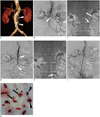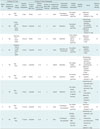Abstract
Objective
Materials and Methods
Results
Figures and Tables
Fig. 1
88-year-old female presented with abdominal pain and hematochezia.

Table 1
Summary of Clinical Features of Nine Patients with SMA Embolism

Normal range: WBC count = 4.0-10.0 (× 103/uL), CRP = 0-0.5 (mg/dL), Serum Cr = 0.70-1.40 (mg/dL). *Symptoms and laboratory tests were based on physical examination and blood samples at admission, †Transthoracic echocardiography was performed in patients 1, 3, 4, 5, 8, and 9. Transesophageal echocardiography was performed in patient 6. Af = atrial fibrillation, CAD = coronary artery disease, CHF = congestive heart failure, CRP = C-reactive protein, DCMP = dilated cardiomyopathy, DM = diabetes mellitus, LA = left atrium, LV = left ventricle, MR = mitral regurgitation, MVR = mitral valve replacement, NA = not applicable, SMA = superior mesenteric artery, TVR = tricuspid valve replacement, WBC = white blood cell
Table 2
Summary of Intervention and Clinical Outcomes of 9 Patients with SMA Embolism

*Thrombolysis using urokinase was performed for 24 hours, but no improvement was noted. Then, aspiration thrombectomy was performed, †Aspiration thrombectomy was performed, but residual thrombus in ileal branch was noted. Then, thrombolysis using urokinase was performed for 10 hours, ‡Thrombolysis using urokinase was performed for 8 hours, but abundant residual thrombus was noted. Then, aspiration thrombectomy was performed and small residual thrombus in ileal branch was noted. Then additional thrombolysis using urokinase was performed for 6 hours, §Thrombolysis using urokinase was performed for 9 hours, but abundant residual thrombus was noted. Then, aspiration thrombectomy was performed. SMA = superior mesenteric artery




 PDF
PDF ePub
ePub Citation
Citation Print
Print


 XML Download
XML Download